
Only two and a half miles north of Depoe Bay is Fogarty Creek Beach, the destination for today’s morning walk. Specifically, we are visiting the south side of the creek and arrive with big expectations of seeing small things.

This morning was low tide, so low that it’s referred to as a negative tide, meaning even more seafloor than normal is exposed. This phenomenon will be continuing through the weekend, though we are expecting throngs of people to show up on Saturday and Sunday to visit the tidepools along with us. Today, though, we were nearly alone out here, just us, the sea stars, some cormorants, and a few people here and there during the nearly two hours we peered into pools, cracks, crevices, and right upon the surfaces where the exposed sea life clings fast waiting for the return of their universe.

Blue mussels had me feeling inspired to buy a harvesting permit from the state of Oregon, but Caroline reminded me that there was a warning sign, which I even took a photo of (see above), that there is a toxin in shellfish along the coast that makes them too dangerous to eat. Drats.

Caroline was enchanted upon learning that the German name of chitons is Kaeferschnecke or beetle snail. If you are wondering why that’s special, you’d need to know something about her childhood family nickname: Schnecke (snail). The specimen seen here is a lined chiton (Tonicella lineata).

While there were only a few tide pools holding enough water for the sea anemones to be open, what there was can only be described as perfect. Such beautiful animals.

A scene of relative calm, tranquil even, just some sea stars and anemones living as neighbors.

The same cannot be said for the crowd here at the buffet. Sea stars love eating mollusks, and of course, YouTube was happy to oblige me with a video, replete with menacing music, a haunting voice narrating the horror about to unfold (meaning the stomach of the sea star), and some obligatory sound effects of sloshing and slurping to accompany the sea star monster turning the nice pink mussel with no means of escape into a nutrient-rich soup, a broth quickly absorbed by this terror of the ocean.

Chitons, on the other hand, eat algae, which I’ll trust Claude to have figured out correctly and leave YouTube alone, as I’m sure some macabre idiot probably gave these black Katy chitons (Katharina tunicata) the sensationalized treatment, too.

The closer I moved the camera, the deeper this striped shore crab crawled into the crevice it was inhabiting. I probably stood on a nearby rock waiting for a solid 15 minutes. During that time, he couldn’t help himself as sea roaches passed by, and he lunged to nab one, remaining cautious about how far he exposed himself.

Anemones control the universe; each anemone is a universe unto itself. God is a psychedelic anemone.

But not the green ones. Green anemones are the sports fans of the aquatic world, just hanging out, drinking, and telling stupid jokes.

Ligia exotica, a.k.a. the sea roach or sea slater, is a tasty morsel for striped shore crabs.

These gooseneck barnacles cost about $100 a pound in Spain and Portugal, but here in America, there is no market for them. Good thing for the sea stars who have them all to themselves. Yep, I turned back to YouTube for an old video I had watched some time ago about eating these. It is the peduncle and what they hold that makes them attractive for eating. If the shellfish ban wasn’t in effect right now, Caroline and I would be adding some of these to a collection of mussels for dinner.

I should have used fewer images of anemones; I’ve got nothing to say about this cluster except to state the obvious: they are pretty.

Every time we are on the coast, we learn something new, many new things really, such as that breeding cormorants have a tuft of white plumage. The other day, we learned about their eye color and how it helps them while hunting underwater, and now we discover an iridescent sheen on their necks. When the mate flew into the nest, I was able to watch and listen to their cooing, rubbing necks and beaks, and all that flirty stuff that lets other cormorants know that these two are a pair.
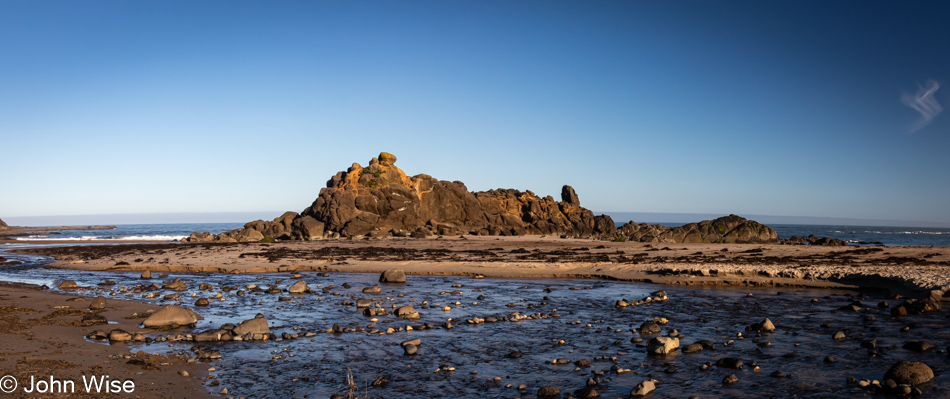
So, this was Fogarty Creek during low tide. It’ll be difficult not to return tomorrow, but choosing another site means we might see and learn about other new things.
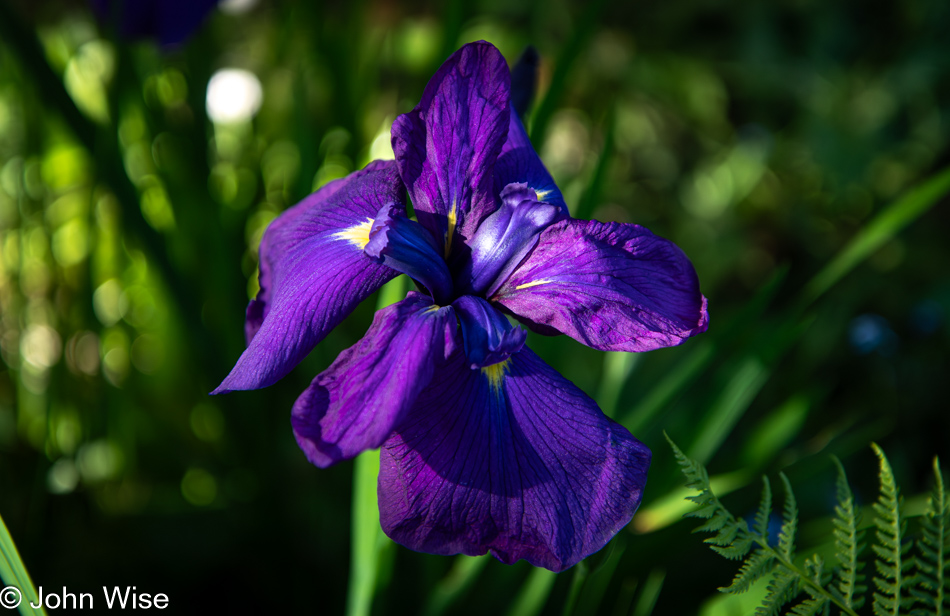
As if I didn’t have enough to write about, I thought about all the flowers I see here at the house, and after thinking about the photo of the iris I took last night, I felt inspired to capture the various blossoms while the weather is nice and the flowers are still in good form. Sure, this is the same iris I photographed yesterday, but this is in morning light instead of late afternoon. Plus, I couldn’t have a comprehensive visual list of the flowers without including it.

With my eyes darting to and fro, scanning the property, it was this aster that caught my attention next.

A blackberry blossom teases me because we’ll likely be gone before this summertime fruit reaches peak sweetness. Good thing I have a sweet wife to turn to when the rest of nature isn’t ready to share yet.

It is the roses that I see first when looking over my right shoulder and out the window next to the front door.

Just a hint of the lilies can be seen over the rail of the deck on the western side of the house, in front of the roses, but mostly out of view until I stand up.

Seriously? This is Escential™ Raspberry Lemonade, yep, a trademarked plant.

According to visual search functions, these are Veronica snow candles.

While hydrangeas might be obvious to others, again, I needed to turn to the internet to identify these blossoms.

The older I get, the dumber I must become, as even the common azalea was outside the sphere of my knowledge. I’m groaning here admitting this as I just know that my wife will come over while editing this post and, in her thickest German accent, say, “Really, John, you didn’t know that those were azaleas and hydrangeas? You probably had to look up the rose, too, huh?” [Truthfully, I did not recognize the azalea but was able to identify the hydrangea – Caroline]

Finally, we arrive at the meadow buttercups that are in abundance here, and this concludes the first part of the day. In a minute, after putting my writing fingers away, I’ll get to taking care of portioning our leftovers from yesterday’s lunch, and then for the next nearly four hours, we’ll be either up or maybe down the road. I leave that choice to Caroline as she scours options while I ready our dinner.
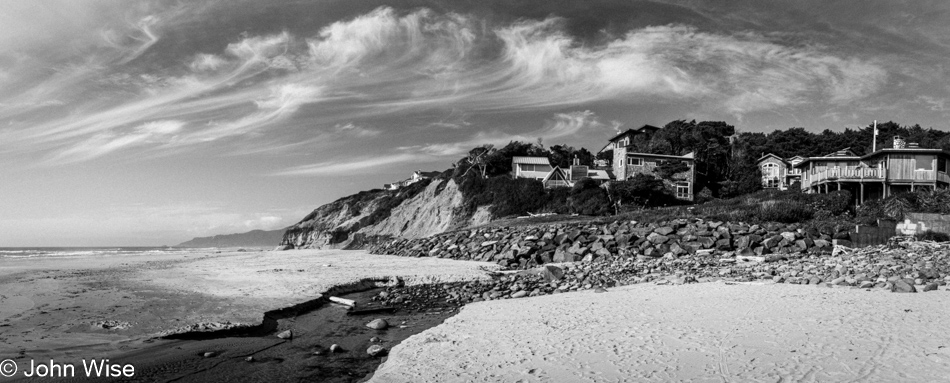
How often has it happened to you that you were on your way to the photo shoot, and at the last second, you decided to load up some Kodak Tri-X instead of the old Kodacolor? Everything old being new again, I suppose I shouldn’t joke as it’s within reason to assume I could be shooting with my old Ricoh KR-5. As a matter of fact, it’s a bit sad that I no longer possess those skills to manually set everything on a camera and then developing the film it at home. All that aside, the truth of this switch to black & white partway through the day is actually mundane. There were a few images below that played well sans color, and I didn’t like switching back and forth between black & white and color, so the rest of the day had to be desaturated. We are visiting Moolack Beach north of Newport this afternoon.

Where are the marine biologists when you need one? For years, Caroline and I have been enamored with these patterns in the moist sand that, if I think hard about it, are seen following the tide going out. We’ve never seen them being made, that was until today. In the lower right corner is a small beetle-like thing, not the blob on the far edge, that is walking around but doesn’t seem to be making a deep enough impression. After a ton of research, maybe more than 5 or 10 minutes worth, it appears that these impressions are being made by foraging sand hoppers, a.k.a. the lowly sand flea. This would make a lot of sense because, as I said, we never see what’s making the patterns, and it is a characteristic of the sand hoppers that, when threatened, such as when humans approach, they jump away. Add to that that they are scavenging organic matter on the beach: as the tide recedes, debris is often left behind, so the sand fleas are out wandering the domain of where their tiny legs will take them without having to expend the energy required to perform those fantastic leaps out of harm’s way.
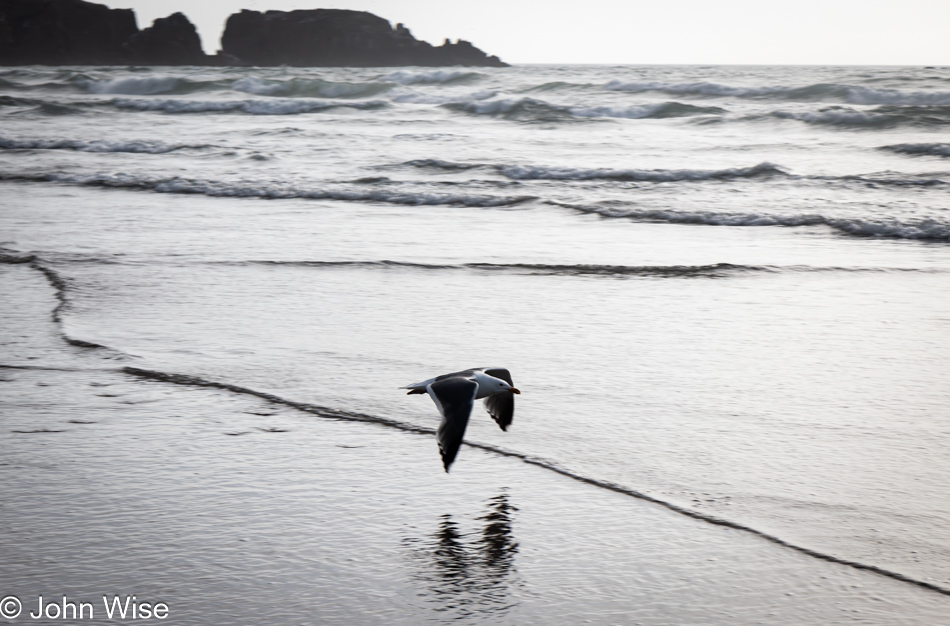
This was the image that started the whole black & white sequence of thoughts. The gull was standing on a still wet edge of the shore with a perfect mirror of itself. I set my exposure for that image, but then the gull started flying away, and I felt close enough to get a nice photo of it in flight. Obviously, I was overexposed for anything other than shooting against the darker background and sand, and as I panned with the camera to capture the bird flying away, I got this blown-out image where only the yellow-orange of the beak had color. While I liked that, I liked the high-contrast effect of the black & white ‘Punch’ filter even more, and to have some uniformity between these afternoon images, I treated them all with the same filter.
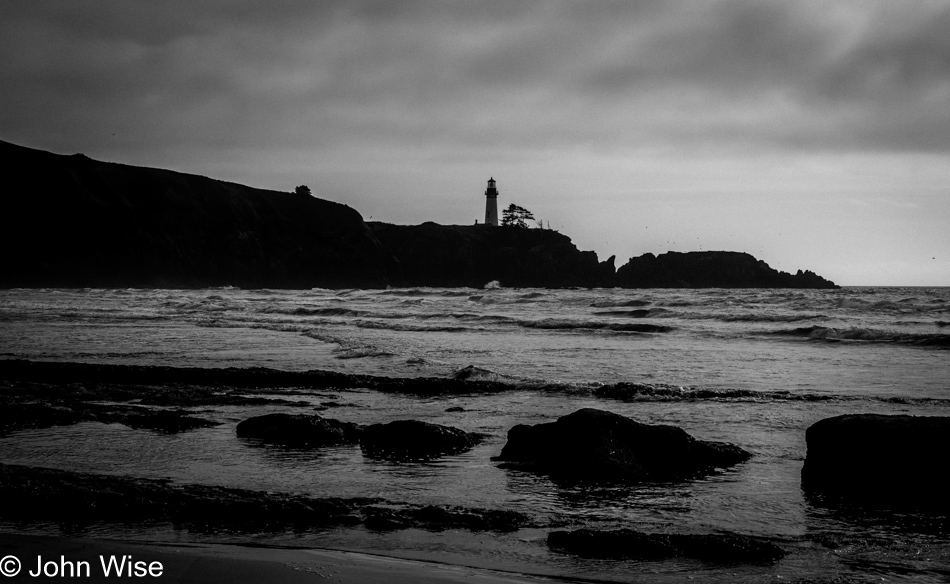
I intentionally set my light balance on the sky after zooming into a brighter area, as I wanted to achieve a silhouetted image of the lighthouse against the overcast sky. Between the time we walked down on the beach and the point we arrived as close as we’d come to the Yaquina Head Lighthouse, the sun had been blotted out by a thick band of fast-moving clouds that also dropped the temperature enough that we were nearly frozen by the time we got back to the car. Thank you, Kia, for putting heated seats in our car.

Earlier, I wrote about my desire to try eating barnacles and wondered out loud why we don’t eat them in America. Well, it’s a day later when I’m finishing this post, and I’ve had time to think about that. I’m no longer interested unless I’m in Spain or Portugal, where they cost $100 a pound, as the high price would dissuade people from over-collecting them. Why the change of heart? A gooseneck barnacle needs 2.5 to 3 years to reach a couple of inches in length, and they can live for up to 20 years, compared to cattle that we harvest in about 18 months, collecting about 720 to 896 pounds (327 to 406 kg) of meat from the 1,200-pound animal. Then there are chickens that we slaughter at eight weeks, providing us with about 5-6 pounds (2.3-2.7 kg) of meat. I guess I’m happy we’ve not found a market for barnacles, otherwise, there’d be none here at the shore during low tide to admire.

This was the photo that absolutely convinced me that it was going to be black & white.

As the cloud bank ripped by on its way south, there were fleeting moments where a muted image of the sun could be seen with the naked eye. There was no risk of rain, though this heavy, dark cloud might suggest an imminent downpour. It is merely an effect of the photographic technique and post-processing.

You’ll have to take my word for it that this clover blossom was a riot of color; I couldn’t very well jump out of the aesthetic sense I was using to finish the day now, could I?